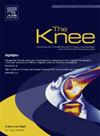Suspensory screw fixation does not lead to increased tunnel widening in Anterior Cruciate Ligament reconstruction: a randomized controlled trial comparing interference and suspensory screw fixation
IF 2
4区 医学
Q3 ORTHOPEDICS
引用次数: 0
Abstract
Purpose
Fixation of Anterior Cruciate Ligament (ACL) grafts inside the tunnels can broadly be achieved by interference screw fixation or suspensory fixation. The aim of this study was to compare the two fixation techniques using Magnetic Resonance Imaging (MRI).
Methods
This Randomized Controlled Trial allocated patients into two groups: aperture fixation (AF) with interference screw and suspensory screw (SF) fixation with a tape-locking screw construct. The primary outcome was tunnel widening at 1 year. The secondary outcomes were KT-1000 knee laxity and patient reported outcomes by IKDC, Lysholm, KOOS-QoL, VAS and Tegner activity scores. Intraclass and interclass correlation for tunnel widening measurements were obtained and the effects of fixation technique on change in tunnel size was estimated using linear regression modelling.
Results
Sixty patients were included and randomized, 29 to AF and 31 to SF technique. Fifty-four patients completed clinical follow-up of whom 50 underwent MRI investigation. The baseline demographics did not differ between the groups. There was no significant difference in mean tibial or femoral aperture widening between the groups. The AF tibial widening was 46 % (SD 28 %) and the SF tibial widening was 38 % (SD 25 %) (P = NS). The AF femoral tunnel widening was 21 % (SD 44 %) compared to 42 % (SD 33 %) in SF (P = NS). The mean ACL graft size for the AF group was 7.4 mm (SD 0.5 mm) and 8.3 mm (SD 0.7 mm) for the SF group. The side-to-side KT-1000 laxity was comparable between the groups. Also, there was no significant difference between in patient reported outcome scores at 1 or 2 years for any of the clinical outcome measures.
Conclusion
This study demonstrates no difference in tunnel widening or clinical outcomes between suspensory screw fixation and aperture screw fixation. Clinically, this suggests that neither technique is inferior for surgeon choice, but longer term follow up and repeat imaging is required.
在前交叉韧带重建中,悬吊螺钉固定不会导致隧道增宽:一项比较干涉和悬吊螺钉固定的随机对照试验
目的对隧道内前交叉韧带(ACL)移植物进行干涉螺钉固定或悬吊固定均可实现广泛的固定。本研究的目的是比较使用磁共振成像(MRI)的两种固定技术。方法随机对照试验将患者分为两组:干涉螺钉孔固定(AF)组和带锁螺钉结构悬吊螺钉固定(SF)组。主要结局是1年后隧道拓宽。次要结果是KT-1000膝关节松弛度和患者报告的IKDC、Lysholm、KOOS-QoL、VAS和Tegner活动评分。研究了隧道加宽测量的类内和类间相关性,并利用线性回归模型估计了固定技术对隧道尺寸变化的影响。结果共纳入60例患者,其中AF组29例,SF组31例。54例患者完成了临床随访,其中50例进行了MRI检查。两组之间的基线人口统计数据没有差异。两组间胫骨和股骨孔径的平均宽度无显著差异。后侧胫骨加宽46% (SD 28%),顺侧胫骨加宽38% (SD 25%) (P = NS)。AF组股骨隧道拓宽21% (SD 44%), SF组42% (SD 33%) (P = NS)。AF组的平均ACL移植大小为7.4 mm (SD 0.5 mm), SF组的平均ACL移植大小为8.3 mm (SD 0.7 mm)。两组之间的KT-1000侧对侧松弛度具有可比性。此外,对于任何临床结果测量,患者报告的1年或2年的结果评分之间没有显着差异。结论悬吊螺钉与开孔螺钉在隧道加宽及临床效果上无差异。临床上,这表明这两种技术都不是外科医生的选择,但需要长期随访和重复成像。
本文章由计算机程序翻译,如有差异,请以英文原文为准。
求助全文
约1分钟内获得全文
求助全文
来源期刊

Knee
医学-外科
CiteScore
3.80
自引率
5.30%
发文量
171
审稿时长
6 months
期刊介绍:
The Knee is an international journal publishing studies on the clinical treatment and fundamental biomechanical characteristics of this joint. The aim of the journal is to provide a vehicle relevant to surgeons, biomedical engineers, imaging specialists, materials scientists, rehabilitation personnel and all those with an interest in the knee.
The topics covered include, but are not limited to:
• Anatomy, physiology, morphology and biochemistry;
• Biomechanical studies;
• Advances in the development of prosthetic, orthotic and augmentation devices;
• Imaging and diagnostic techniques;
• Pathology;
• Trauma;
• Surgery;
• Rehabilitation.
 求助内容:
求助内容: 应助结果提醒方式:
应助结果提醒方式:


